The cobalt resinate market is projected to expand from USD 809.4 million in 2025 to USD 1,4771.1 million in 2035, growing at a CAGR of 6.2%. Value chain integration plays a defining role in how producers secure raw materials, capture margins, and position themselves across specialty chemical applications. Backward, forward, and horizontal integration models influence cost efficiency, competitiveness, and resilience to volatility.
Backward integration remains significant because cobalt resinate relies on metal cobalt inputs and organic resin feedstocks. Producers with access to cobalt mining or refined intermediates can reduce cost pressures created by global cobalt supply fluctuations. Mining and refining are highly concentrated in regions like the Democratic Republic of Congo, where geopolitical instability and environmental scrutiny create risks. Companies with backward linkages into cobalt chemicals improve price stability and mitigate supply chain disruption. Integration into resin intermediates, such as colophony or synthetic resins, further strengthens cost control and product quality consistency.
Forward integration shapes how cobalt resinate reaches end-use applications. The compound is widely adopted in inks, varnishes, paints, and specialty coatings due to its drying and hardening properties. Manufacturers that expand downstream into paint formulations, printing ink solutions, or polymer coating additives capture additional margin while differentiating their offerings. Forward integration also supports stronger customer relationships by providing tailored solutions for specific industrial segments such as packaging, automotive finishes, or electronics coatings. This approach reduces dependency on commodity resin sales and increases exposure to high-value specialty chemicals markets.
Horizontal integration across chemical categories creates further opportunities. Producers often expand into related cobalt-based compounds such as cobalt octoate, cobalt naphthenate, or other metal-organic complexes used in coatings and polymers. This strategy enhances portfolio diversity and allows companies to service multiple demand streams across construction, automotive, packaging, and energy sectors. Integration across multiple cobalt derivatives ensures resilience during cyclical shifts in individual product demand while leveraging common production expertise.
Environmental and regulatory pressures are influencing integration decisions. Stricter regulations on cobalt mining practices and chemical emissions encourage investment in traceability and cleaner production technologies. Companies that integrate across the value chain are better positioned to demonstrate compliance with REACH, EPA, and local frameworks while offering certified low-emission solutions to customers. This regulatory-driven integration also strengthens competitiveness in regions where end users prioritize sustainable sourcing.
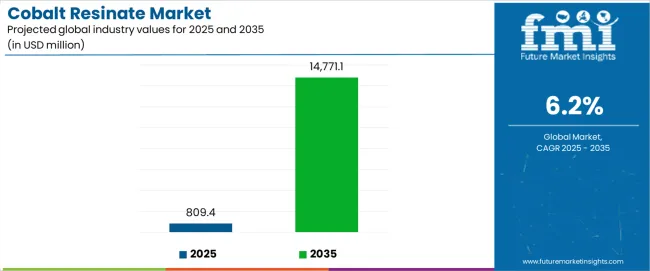
Between 2025 and 2030, the cobalt resinate market is projected to expand from USD 809.4 million to USD 1,093.5 million, resulting in a value increase of USD 284.1 million, which represents 42.5% of the total forecast growth for the decade. This phase of development will be shaped by increasing adoption of advanced drying technologies in coating formulations, rising demand for high-performance siccative solutions in industrial applications, and growing emphasis on accelerated curing systems with enhanced efficiency characteristics. Paint and coatings manufacturers are expanding their cobalt resinate applications to address the growing demand for rapid-dry formulations, decorative coatings, and specialty finishing requirements.
| Metric | Value |
|---|---|
| Estimated Value in (2025E) | USD 809.4 million |
| Forecast Value in (2035F) | USD 1,4771.1 million |
| Forecast CAGR (2025 to 2035) | 6.2% |
From 2030 to 2035, the cobalt resinate market is forecast to grow from USD 1,093.5 million to USD 1,4771.1 million, adding another USD 383.6 million, which constitutes 57.5% of the overall ten-year expansion. This period is expected to be characterized by the expansion of environmentally conscious coating technologies, the integration of advanced metallic drier systems, and the development of multi-functional catalyst platforms with enhanced performance capabilities. The growing adoption of high-efficiency paint formulations will drive demand for cobalt resinate with superior catalytic activity and compatibility with advanced coating chemistries across industrial and decorative applications.
Between 2020 and 2025, the cobalt resinate market experienced steady growth, driven by increasing demand for modern coating technologies and growing recognition of metallic driers as essential components for efficient paint formulations across industrial coatings, architectural paints, and specialty finishing applications. The cobalt resinate market developed as manufacturers recognized the potential for cobalt compounds to accelerate oxidative drying while maintaining coating quality and enabling enhanced application properties. Technological advancement in organometallic chemistry and precision catalyst formulation began emphasizing the critical importance of maintaining catalytic efficiency and stability consistency in diverse coating environments.
Market expansion is being supported by the increasing global demand for rapid-drying coating solutions and the corresponding need for efficient catalyst systems that can provide superior drying acceleration and curing performance while enabling reduced processing times and enhanced productivity across various paint and coatings manufacturing applications. Modern coating formulations and industrial paint producers are increasingly focused on implementing drier technologies that can deliver accelerated curing, prevent coating defects, and provide consistent performance throughout complex application conditions and diverse substrate materials. Cobalt resinate's proven ability to deliver exceptional catalytic activity against oxidative polymerization, enable time-efficient processing, and support cost-effective formulation protocols make them essential components for contemporary coatings and industrial paint operations.
The growing emphasis on coating performance and manufacturing efficiency is driving demand for cobalt resinate that can support large-scale production requirements, improve film formation outcomes, and enable automated processing systems. Manufacturers' preference for catalysts that combine effective drying acceleration with operational reliability and formulation compatibility is creating opportunities for innovative cobalt resinate implementations. The rising influence of high-performance coatings and advanced paint technologies is also contributing to increased demand for cobalt resinate that can provide precise catalytic control, enhanced stability characteristics, and reliable performance across extended storage periods.
The cobalt resinate market is poised for steady growth and technological advancement. As industries across paint manufacturing, industrial coatings, decorative finishes, and specialty chemicals seek solutions that deliver exceptional catalytic efficiency, processing reliability, and formulation compatibility, cobalt resinate is gaining prominence not just as a drying catalyst but as strategic enablers of modern coating technologies and paint production.
Rising high-performance coating adoption in Asia-Pacific and expanding industrial paint initiatives globally amplify demand, while manufacturers are leveraging innovations in organometallic chemistry, advanced purification systems, and integrated catalyst technologies.
Pathways like high-purity catalyst systems, nano-enhanced formulations, and specialized coating applications promise strong margin uplift, especially in industrial and architectural segments. Geographic expansion and technology integration will capture volume, particularly where local coating industries and paint manufacturing adoption are critical. Regulatory support around coating performance standards, environmental compliance requirements, and manufacturing efficiency guidelines give structural support.
The cobalt resinate market is segmented by form, application, end-use sector, purity grade, and region. By form, the cobalt resinate market is divided into liquid and solid categories. By application, it covers chemicals, textiles, automobiles, aerospace, and others. By end-use sector, it is categorized into paint and coatings, industrial manufacturing, specialty chemicals, and research institutions. By purity grade, it includes standard grade (95-98%) and high-purity grade (≥99%). Regionally, the market is divided into North America, Europe, East Asia, South Asia & Pacific, Latin America, and the Middle East & Africa.
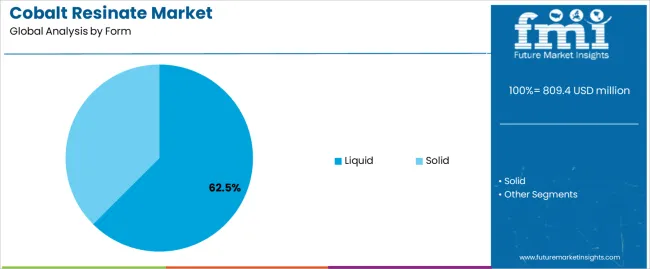
The liquid segment is projected to account for 62.5% of the cobalt resinate market in 2025, reaffirming its position as the leading form category. Paint and coatings manufacturers and industrial formulators increasingly utilize liquid cobalt resinate for their superior mixing characteristics when operating across diverse formulation systems, excellent solubility properties, and cost-effectiveness in applications ranging from architectural paints to high-performance industrial coatings. Liquid cobalt resinate technology's advanced dispersion capabilities and enhanced handling characteristics directly address the industrial requirements for consistent catalyst distribution in large-scale coating manufacturing environments.
This form segment forms the foundation of modern paint and coatings operations, as it represents the catalyst type with the greatest processing convenience and established market demand across multiple application categories and industrial sectors. Manufacturer investments in enhanced stability formulations and improved packaging systems continue to strengthen adoption among coating producers and paint manufacturers. With companies prioritizing processing efficiency and formulation optimization, liquid cobalt resinate aligns with both performance requirements and operational efficiency objectives, making it the central component of comprehensive coating catalyst strategies.
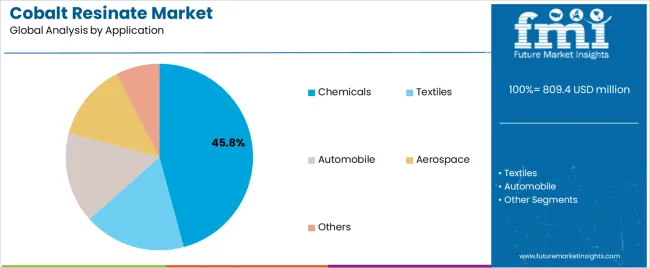
Chemical applications are projected to represent 45.8% of cobalt resinate demand in 2025, underscoring their critical role as the primary industrial consumers of metallic drier technology for paint formulations, coating systems, and specialty chemical production applications. Chemical manufacturers prefer cobalt resinate for their exceptional catalytic efficiency capabilities, precise control characteristics, and ability to enhance polymerization rates while ensuring effective curing throughout diverse chemical processing programs. Positioned as essential components for modern chemical manufacturing operations, cobalt resinate offers both performance advantages and process optimization benefits.
The segment is supported by continuous innovation in organometallic catalyst technologies and the growing availability of specialized formulation systems that enable controlled release mechanisms with enhanced activity profiles and rapid processing capabilities. Additionally, chemical manufacturers are investing in advanced purification systems to support high-performance cobalt resinate utilization and quality control. As specialty chemicals demand becomes more prevalent and processing efficiency requirements increase, chemical applications will continue to dominate the end-use market while supporting advanced catalyst utilization and industrial processing strategies.
The cobalt resinate market is advancing steadily due to increasing demand for efficient drying catalyst technologies and growing adoption of high-performance coating systems that provide superior catalytic activity and processing efficiency while enabling reduced curing times across diverse paint and coatings manufacturing applications. However, the cobalt resinate market faces challenges, including raw material price volatility, environmental regulations concerning cobalt compounds, and the need for specialized handling procedures and safety protocols. Innovation in alternative metal catalyst systems and environmentally conscious formulations continues to influence product development and market expansion patterns.
The growing adoption of advanced coating formulations, specialty paint systems, and high-performance industrial applications is enabling manufacturers to produce premium cobalt resinate with superior catalytic properties, enhanced stability characteristics, and specialized performance functionalities. Advanced specialty applications provide improved market positioning while allowing more efficient resource utilization and consistent performance across various coating types and application conditions. Manufacturers are increasingly recognizing the competitive advantages of specialty cobalt resinate capabilities for market differentiation and premium positioning.
Modern cobalt resinate producers are incorporating environmental management systems, alternative catalyst research, and reduced-impact manufacturing processes to enhance regulatory compliance, enable cleaner production capabilities, and deliver value-added solutions to environmentally conscious customers. These technologies improve manufacturing acceptability while enabling new application capabilities, including low-emission formulations, reduced environmental impact, and enhanced worker safety protocols. Advanced environmental integration also allows manufacturers to support comprehensive coating systems and industrial modernization beyond traditional catalyst approaches.
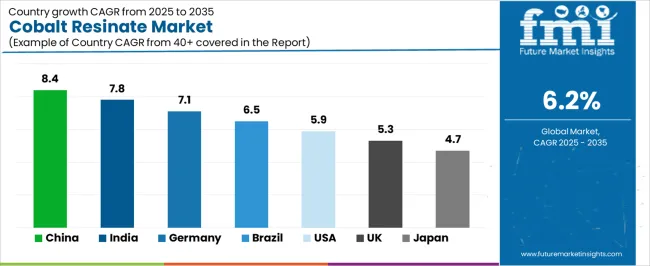
| Country | CAGR (2025-2035) |
|---|---|
| China | 8.4% |
| India | 7.8% |
| Germany | 7.1% |
| Brazil | 6.5% |
| USA | 5.9% |
| UK | 5.3% |
| Japan | 4.7% |
The cobalt resinate market is experiencing steady growth globally, with China leading at an 8.4% CAGR through 2035, driven by the expanding paint and coatings industry, growing industrial manufacturing sector, and significant investment in chemical production development. India follows at 7.8%, supported by government initiatives promoting manufacturing growth, increasing industrial development demand, and growing coating application requirements.
Germany shows growth at 7.1%, emphasizing advanced chemical manufacturing and high-performance coating technology development. Brazil records 6.5%, focusing on industrial expansion and manufacturing sector modernization. The USA demonstrates 5.9% growth, prioritizing coating performance standards and chemical manufacturing excellence. The UK exhibits 5.3% growth, emphasizing specialty chemicals development and advanced coating technologies. Japan shows 4.7% growth, supported by high-tech manufacturing initiatives and precision coating applications.
The report covers an in-depth analysis of 40+ countries, the top-performing countries are highlighted below.
Revenue from cobalt resinate in China is projected to exhibit exceptional growth with a CAGR of 8.4% through 2035, driven by expanding paint and coatings manufacturing sector and rapidly growing chemical industry development supported by government initiatives promoting industrial modernization. The country's strong position in chemical production and increasing investment in advanced manufacturing infrastructure are creating substantial demand for high-quality cobalt resinate solutions. Major chemical manufacturers and coating producers are establishing comprehensive catalyst supply capabilities to serve both domestic industrial demand and international chemical markets.
Revenue from cobalt resinate in India is expanding at a CAGR of 7.8%, supported by the country's growing industrial sector, expanding government support for manufacturing development, and increasing adoption of advanced coating technologies. The country's initiatives promoting industrial growth and rising manufacturer awareness are driving requirements for high-performance catalyst capabilities. International suppliers and domestic producers are establishing extensive production and distribution capabilities to address the growing demand for cobalt resinate products.
Revenue from cobalt resinate in Germany is expanding at a CAGR of 7.1%, supported by the country's advanced chemical industry capabilities, strong emphasis on manufacturing technology innovation, and robust demand for high-performance catalyst systems in coating and chemical manufacturing applications. The nation's mature chemical sector and efficiency-focused operations are driving sophisticated cobalt resinate systems throughout the manufacturing industry. Leading chemical companies and technology providers are investing extensively in advanced catalyst technologies and precision formulation systems to serve both domestic and international markets.
Revenue from cobalt resinate in Brazil is growing at a CAGR of 6.5%, driven by the country's expanding industrial sector, growing manufacturing operations, and increasing investment in chemical industry development. Brazil's large industrial capacity and commitment to manufacturing modernization are supporting demand for efficient cobalt resinate solutions across multiple industrial production segments. Manufacturers are establishing comprehensive supply capabilities to serve the growing domestic market and industrial export opportunities.
Revenue from cobalt resinate in the USA is expanding at a CAGR of 5.9%, supported by the country's advanced chemical technology sector, strategic focus on manufacturing efficiency, and established specialty chemical capabilities. The USA's chemical innovation leadership and technology integration are driving demand for cobalt resinate in industrial manufacturing, specialty coatings, and advanced chemical applications. Manufacturers are investing in comprehensive technology development to serve both domestic chemical markets and international specialty applications.
Revenue from cobalt resinate in the UK is growing at a CAGR of 5.3%, driven by the country's focus on specialty chemical advancement, emphasis on manufacturing efficiency, and strong position in advanced coating development. The UK's established chemical innovation capabilities and commitment to manufacturing modernization are supporting investment in advanced cobalt resinate technologies throughout major industrial regions. Industry leaders are establishing comprehensive technology integration systems to serve domestic manufacturing operations and specialty chemical applications.
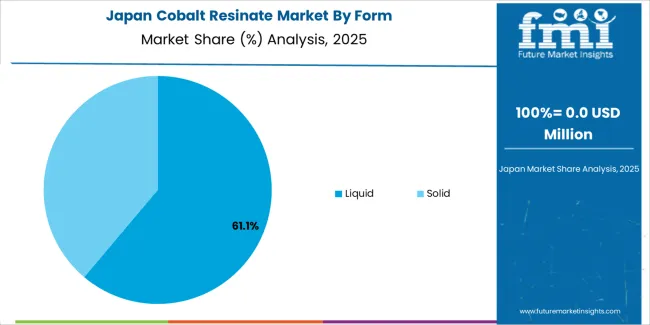
Revenue from cobalt resinate in Japan is expanding at a CAGR of 4.7%, supported by the country's high-tech chemical initiatives, growing specialty manufacturing sector, and strategic emphasis on precision technology development. Japan's advanced technology capabilities and integrated chemical systems are driving demand for premium cobalt resinate in high-performance applications, specialty coatings, and precision chemical manufacturing. Leading manufacturers are investing in specialized capabilities to serve the stringent requirements of high-tech manufacturing and precision chemical industries.
The cobalt resinate market in Europe is projected to grow from USD 162.4 million in 2025 to USD 296.8 million by 2035, registering a CAGR of 6.2% over the forecast period. Germany is expected to maintain its leadership position with a 34.8% market share in 2025, declining slightly to 34.2% by 2035, supported by its strong chemical manufacturing sector, advanced coating technology capabilities, and comprehensive specialty chemical industry serving diverse cobalt resinate applications across Europe.
France follows with a 19.2% share in 2025, projected to reach 19.8% by 2035, driven by robust demand for cobalt resinate in specialty chemical production, industrial coating applications, and advanced manufacturing programs, combined with established chemical technology infrastructure and precision catalyst expertise. The United Kingdom holds a 16.5% share in 2025, expected to reach 16.9% by 2035, supported by strong specialty chemical sector and growing advanced manufacturing activities. Italy commands a 13.1% share in 2025, projected to reach 13.4% by 2035, while Spain accounts for 8.8% in 2025, expected to reach 9.1% by 2035.
The Netherlands maintains a 4.2% share in 2025, growing to 4.3% by 2035. The Rest of Europe region, including Nordic countries, Eastern Europe, Belgium, Poland, and other nations, is anticipated to maintain momentum, with its collective share moving from 3.4% to 2.3% by 2035, attributed to increasing chemical manufacturing in Eastern Europe and growing specialty chemical penetration in Nordic countries implementing advanced catalyst technology programs.
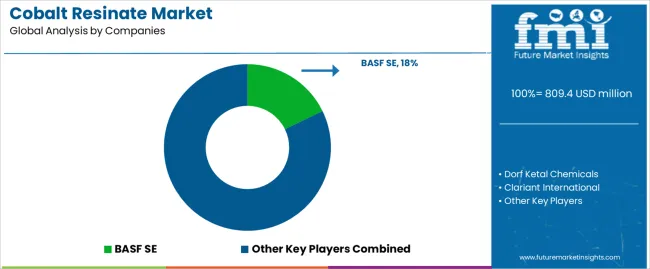
The cobalt resinate market is characterized by competition among established chemical manufacturers, specialized catalyst producers, and integrated specialty chemical solutions providers. Companies are investing in organometallic chemistry research, purity optimization, advanced formulation development, and comprehensive product portfolios to deliver consistent, high-performance, and application-specific cobalt resinate solutions. Innovation in environmental compliance systems, catalyst stability enhancement, and processing efficiency improvement is central to strengthening market position and competitive advantage.
BASF SE leads the cobalt resinate market with a strong market share, offering comprehensive specialty chemical solutions including advanced catalyst systems with a focus on industrial and coating applications. Dorf Ketal Chemicals provides specialized organometallic catalyst capabilities with an emphasis on high-purity formulations and custom chemical solutions. Clariant International delivers innovative specialty chemicals with a focus on advanced catalyst technologies and industrial chemical services. Elementis Specialties specializes in specialty additives and catalyst systems for high-performance industrial applications. Arkema focuses on advanced chemical technologies and integrated specialty solutions. AkzoNobel offers comprehensive coating and specialty chemical platforms with emphasis on industrial and decorative applications.
| Items | Values |
|---|---|
| Quantitative Units (2025) | USD 809.4 million |
| Form | Liquid, Solid |
| Application | Chemicals, Textiles, Automobile, Aerospace, Others |
| End-Use Sector | Paint and Coatings, Industrial Manufacturing, Specialty Chemicals, Research Institutions |
| Purity Grade | Standard Grade (95-98%), High-Purity Grade (≥99%) |
| Regions Covered | North America, Europe, East Asia, South Asia & Pacific, Latin America, Middle East & Africa |
| Countries Covered | China, India, Germany, Brazil, United States, United Kingdom, Japan and 40+ countries |
| Key Companies Profiled | BASF SE, Dorf Ketal Chemicals, Clariant International, Elementis Specialties, Arkema, and AkzoNobel |
| Additional Attributes | Dollar sales by form and application category, regional demand trends, competitive landscape, technological advancements in organometallic chemistry, catalyst formulation development, environmental compliance innovation, and specialty chemical integration |
The global cobalt resinate market is estimated to be valued at USD 809.4 million in 2025.
The market size for the cobalt resinate market is projected to reach USD 14,771.1 million by 2035.
The cobalt resinate market is expected to grow at a 6.2% CAGR between 2025 and 2035.
The key product types in cobalt resinate market are liquid and solid.
In terms of application, chemicals segment to command 45.8% share in the cobalt resinate market in 2025.






Our Research Products

The "Full Research Suite" delivers actionable market intel, deep dives on markets or technologies, so clients act faster, cut risk, and unlock growth.

The Leaderboard benchmarks and ranks top vendors, classifying them as Established Leaders, Leading Challengers, or Disruptors & Challengers.

Locates where complements amplify value and substitutes erode it, forecasting net impact by horizon

We deliver granular, decision-grade intel: market sizing, 5-year forecasts, pricing, adoption, usage, revenue, and operational KPIs—plus competitor tracking, regulation, and value chains—across 60 countries broadly.

Spot the shifts before they hit your P&L. We track inflection points, adoption curves, pricing moves, and ecosystem plays to show where demand is heading, why it is changing, and what to do next across high-growth markets and disruptive tech

Real-time reads of user behavior. We track shifting priorities, perceptions of today’s and next-gen services, and provider experience, then pace how fast tech moves from trial to adoption, blending buyer, consumer, and channel inputs with social signals (#WhySwitch, #UX).

Partner with our analyst team to build a custom report designed around your business priorities. From analysing market trends to assessing competitors or crafting bespoke datasets, we tailor insights to your needs.
Supplier Intelligence
Discovery & Profiling
Capacity & Footprint
Performance & Risk
Compliance & Governance
Commercial Readiness
Who Supplies Whom
Scorecards & Shortlists
Playbooks & Docs
Category Intelligence
Definition & Scope
Demand & Use Cases
Cost Drivers
Market Structure
Supply Chain Map
Trade & Policy
Operating Norms
Deliverables
Buyer Intelligence
Account Basics
Spend & Scope
Procurement Model
Vendor Requirements
Terms & Policies
Entry Strategy
Pain Points & Triggers
Outputs
Pricing Analysis
Benchmarks
Trends
Should-Cost
Indexation
Landed Cost
Commercial Terms
Deliverables
Brand Analysis
Positioning & Value Prop
Share & Presence
Customer Evidence
Go-to-Market
Digital & Reputation
Compliance & Trust
KPIs & Gaps
Outputs
Full Research Suite comprises of:
Market outlook & trends analysis
Interviews & case studies
Strategic recommendations
Vendor profiles & capabilities analysis
5-year forecasts
8 regions and 60+ country-level data splits
Market segment data splits
12 months of continuous data updates
DELIVERED AS:
PDF EXCEL ONLINE
Cobalt Salt for Tires Market Size and Share Forecast Outlook 2025 to 2035
Cobalt Based Laser Cladding Powder Market Size and Share Forecast Outlook 2025 to 2035
Cobalt Carbonate Market
Tire Cobalt Salt Adhesive Market Size and Share Forecast Outlook 2025 to 2035
Nickel Cobalt Aluminium Market Trend Analysis Based on Purity, End Use, and Region 2025 to 2035
Nickel Cobalt Manganese (NCM) Market Trend Analysis Based on Product, End-Use, and Region 2025 to 2035
Lithium Cobalt Oxide Market Size and Share Forecast Outlook 2025 to 2035
Inorganic Cobalt Blue Pigments Market Size and Share Forecast Outlook 2025 to 2035
Demand for Cobalt Salt Adhesion Promoter for Tires in USA Size and Share Forecast Outlook 2025 to 2035
Demand for Cobalt Salt for Tires in Middle East & Africa Size and Share Forecast Outlook 2025 to 2035

Thank you!
You will receive an email from our Business Development Manager. Please be sure to check your SPAM/JUNK folder too.
Chat With
MaRIA